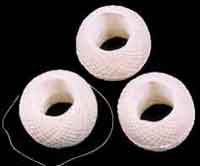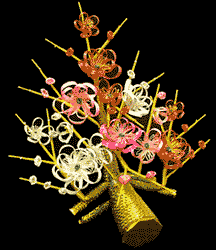History of MizuhikiDo you know history of Iida mizuhiki?
Iida is situated in the southern part of Nagano where 1998 Winter Olympic
and and Paralympic Games were taken place.
Mizuhiki industry has been regarded as the most important one in Iida.
Owing to its silky luster and yet durability Iida Mizuhiki has
made itself renowned.
Mizuhiki is very important in Japanese culture
and in the daily lives of Japanese people.
Mizuhiki‘s importance in Japanese society can be
traced back to the eighth century.
The Early History of Mizuhiki
In the Azuka period, in 607 AD, a Japanese delegate to China (Zui) brought back a gift to the Japanese emperor.
The gift box had on its lid a red and white decoration, made of twine. The decoration symbolized a “safe journey’ for the delegate.
This single gift box and its decoration began a tradition in Japan. Whenever a gift was offered to the Japanese Imperial court, a red and white loose knot-like decoration, using the bonded and dried washi material, was crafted onto the gift box.
In The Heian period, this decoration became known as Mizuhiki.
The Later History of Mizuhiki
In the Edo period in Japan (1611-1869) the head of the Samurai, in The Iida district, now in Nagano prefecture, ordered his Samurai warriors to learn the craft of Mizuhiki. It is thought that this may have been the origin of Mizuhiki in the Iida area.
Samurai warriors wore what are known as Motoyui, “top knots”, and other Japanese people in their hair. Similarly umbrellas and parasols were made using Mizuhiki, because it was both strong and waterproof. Many Japanese people wore Motoyui until the end of the Edo period.
The Meiji period (1869-1914), which followed the Edo period, is the period known by some as “the start of modern Japan”.
The Modern History of Mizuhiki
The end of the Edo period meant the demise of the Samurai and with it the demand for the Motoyui. Many Japanese people adopted lifestyles which were more western, including wearing their hair shorter.The craftsmen of Iida, however, using the knowledge they had acquired over centuries, decided to diversify. They made even stronger and durable Mizuhiki. Subsequently, in the Showa period (1926-1989), different ways of “weaving” Mizuihki were developed.
Today
Mizuhiki art is often seen at Wedding ceremony, for instance, Kimono, wedding dress, and bride's hair clip, table wares, ornaments of the site. It lights up the ceremony.
This tradition of Mizuhiki has continued until the present day and. Seventy eight per cent of all Mizuhiki made in Japan, comes from Iida.
Iida Mizuhiki is recognized by the Japanese Government as the number one Mizuhiki in Japan.Mizuhiki ,and 1998 Nagano Olympics & Paralympics
Mizuhiki Art Gallery

